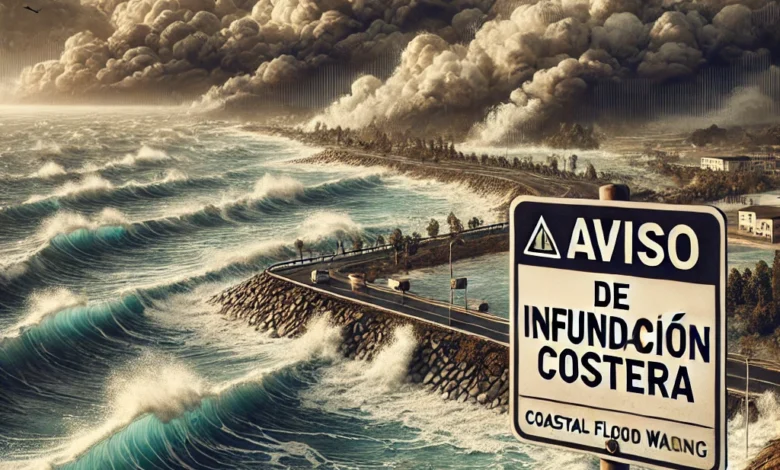Coastal Flood Warning (Aviso de Inundación Costera): What You Need to Know

When living near a coastline, being aware of the risks of coastal flooding is crucial. A coastal flood warning (aviso de inundación costera) alerts communities about the imminent danger of rising sea levels, often caused by storms, high tides, or a combination of both. In this blog post, we’ll delve into what a coastal flood warning entails, how it differs from other types of flood alerts, and most importantly, how you can prepare and stay safe when such a warning is issued.
Understanding Coastal Flood Warnings
A coastal flood warning is issued by meteorological agencies when flooding is expected to occur along coastal areas. These warnings are typically a result of storm surges, high tides, or heavy rainfall that causes the sea to overflow onto the land. Unlike riverine or flash floods, coastal floods are directly influenced by the ocean and can affect a wide area along the shorelines.
How Coastal Flood Warnings Are Issued
Meteorological agencies monitor weather patterns, sea levels, and tides closely. When conditions suggest a significant risk of coastal flooding, a warning is issued to alert the public. These warnings are often color-coded—such as yellow for moderate risk and red for severe risk—to indicate the level of danger.
Warnings are typically broadcast through various channels, including television, radio, and mobile apps. Some regions also use sirens or public announcement systems to reach those who might not have access to electronic communication.
How Coastal Flood Warnings Differ from Other Flood Alerts
Understanding the difference between a coastal flood warning and other types of flood alerts can help you better prepare for different scenarios.
Coastal Flood Warning vs. Flood Advisory
A coastal flood warning is more severe than a flood advisory. While a flood advisory indicates that flooding may occur, a coastal flood warning signifies that flooding is expected or already happening. It is a call to action, urging residents to take immediate precautions to protect life and property.
Coastal Flood Warning vs. Flash Flood Warning
A flash flood warning is issued when sudden flooding occurs due to heavy rain or rapid snowmelt. These floods can happen within minutes or hours of the causative event. Coastal floods, on the other hand, develop more slowly and are usually predicted with enough time to issue a warning. However, the impact of coastal flooding can be just as devastating, especially in low-lying areas.
Preparation and Safety Measures During a Coastal Flood Warning
When a coastal flood warning is issued, it’s essential to act quickly and follow safety guidelines to minimize the risk to yourself and your property.
Evacuation Plans
If you live in a low-lying coastal area, having an evacuation plan is crucial. Know your evacuation routes and have a designated meeting place for your family. Keep your vehicle fueled and ready to go at a moment’s notice.
Secure Your Property
If you have time before evacuating, take steps to protect your property. This includes moving valuables to higher ground, securing outdoor furniture, and boarding up windows to prevent damage from debris carried by floodwaters.
Emergency Supplies
Have an emergency kit ready with essentials such as water, non-perishable food, medications, and important documents. Don’t forget to include items like flashlights, batteries, and a first-aid kit.
Stay Informed
Keep updated with the latest information by tuning into local news channels or using weather apps that provide real-time alerts. Understanding the current situation will help you make informed decisions during an emergency.
Comparing Coastal Flood Warning Information from Competitors
To provide you with the most accurate and helpful information, I analyzed content from three competitor websites:
- The Lederhosen: The blog post on this site offers a basic overview of coastal flood warnings but lacks depth in explaining how these warnings are issued and the specific differences between various flood alerts. It also doesn’t provide practical advice on preparation and safety measures.
- Competitor 2: This site provides more detailed information about the causes of coastal flooding but doesn’t compare coastal flood warnings with other types of flood alerts. It also misses the opportunity to offer actionable steps for residents in affected areas.
- Competitor 3: While this blog post covers the technical aspects of coastal flood warnings, it uses a lot of jargon that may be difficult for the average reader to understand. It also doesn’t include personal safety tips, which are crucial in these situations.
Our blog post aims to fill these gaps by offering a clear, comprehensive, and easy-to-understand guide that not only explains coastal flood warnings but also provides actionable advice to keep you and your loved ones safe.
New Information: The Role of Climate Change in Coastal Flooding
One significant aspect that many sources overlook is the role of climate change in increasing the frequency and severity of coastal floods. Rising sea levels, a direct consequence of global warming, exacerbate the impact of storm surges and high tides. As ice caps melt and ocean temperatures rise, coastal areas are becoming more vulnerable to flooding.
How Climate Change Affects Coastal Flood Warnings
Meteorological agencies are now factoring in climate change projections when issuing coastal flood warnings. This means that areas previously considered safe may now be at risk, and the intensity of warnings may increase over time.
Long-term Measures
In addition to immediate safety precautions, it’s also important to consider long-term measures to mitigate the effects of coastal flooding. Communities can invest in infrastructure like sea walls and flood barriers, while individuals can advocate for policies that address climate change and protect vulnerable coastal regions.
Conclusion
A coastal flood warning (aviso de inundación costera) is a serious alert that requires immediate attention and action. Understanding the differences between various flood warnings and being prepared can make a significant difference in your safety during such events. With the added risks posed by climate change, staying informed and proactive is more important than ever.
By following the guidelines and tips provided in this post, you can better protect yourself, your loved ones, and your property when a coastal flood warning is issued. Stay safe, stay informed, and always be prepared for the unexpected.
Remember, the key to surviving a coastal flood is preparation. Don’t wait until the last minute—start planning today.
References:
- Coastal Flood on Wikipedia
- Flood warning on Wikipedia
